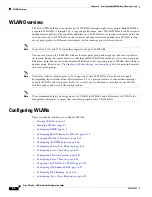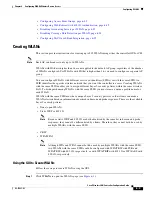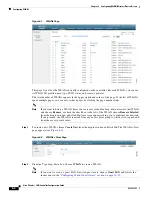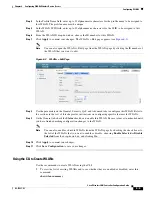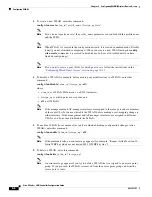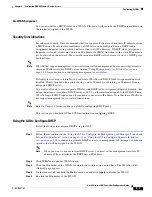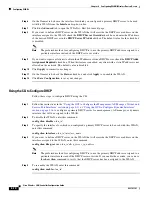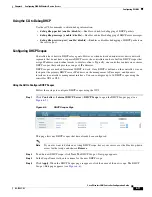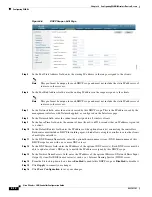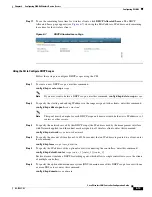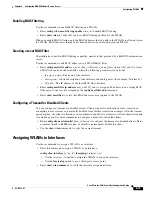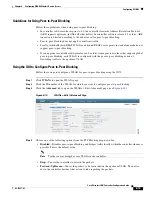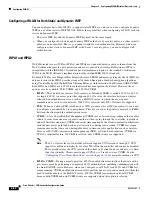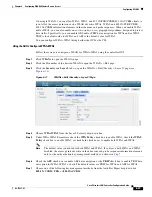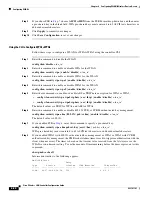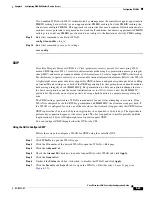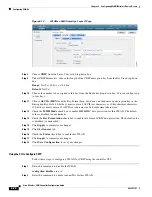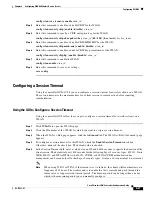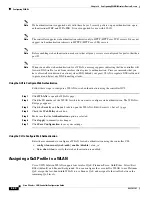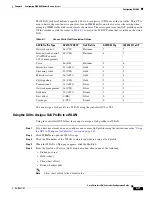
6-16
Cisco Wireless LAN Controller Configuration Guide
OL-17037-01
Chapter 6 Configuring WLANsWireless Device Access
Configuring WLANs
Configuring the DTIM Period
In 802.11a/n and 802.11b/g/n networks, lightweight access points broadcast a beacon at regular
intervals, which coincides with the Delivery Traffic Indication Map (DTIM). After the access point
broadcasts the beacon, it transmits any buffered broadcast and multicast frames based on the value set
for the DTIM period. This feature allows power-saving clients to wake up at the appropriate time if they
are expecting broadcast or multicast data.
Normally, the DTIM value is set to 1 (transmit broadcast and multicast frames after every beacon) or 2
(transmit after every other beacon). For instance, if the beacon period of the 802.11a/n or 802.11b/g/n
network is 100 ms and the DTIM value is set to 1, the access point transmits buffered broadcast and
multicast frames 10 times per second. If the beacon period is 100 ms and the DTIM value is set to 2, the
access point transmits buffered broadcast and multicast frames 5 times per second. Either of these
settings may be suitable for applications, including VoIP, that expect frequent broadcast and multicast
frames.
However, the DTIM value can be set as high as 255 (transmit broadcast and multicast frames after every
255th beacon) if all 802.11a/n or 802.11b/g/n clients have power save enabled. Because the clients have
to listen only when the DTIM period is reached, they can be set to listen for broadcasts and multicasts
less frequently, resulting in longer battery life. For instance, if the beacon period is 100 ms and the DTIM
value is set to 100, the access point transmits buffered broadcast and multicast frames once every 10
seconds, allowing the power-saving clients to sleep longer before they have to wake up and listen for
broadcasts and multicasts, resulting in longer battery life.
Many applications cannot tolerate a long time between broadcast and multicast messages, resulting in
poor protocol and application performance. Cisco recommends a low DTIM value for 802.11a/n and
802.11b/g/n networks that support such clients.
In controller software release 5.0 or later, you can configure the DTIM period for the 802.11a/n and
802.11b/g/n radio networks on specific WLANs. In previous software releases, the DTIM period was
configured per radio network only, not per WLAN. The benefit of this change is that now you can
configure a different DTIM period for each WLAN. For example, you might want to set different DTIM
values for voice and data WLANs.
Note
When you upgrade the controller software to release 5.0 or later, the DTIM period that was configured
for a radio network is copied to all of the existing WLANs on the controller.
Using the GUI to Configure the DTIM Period
Using the GUI, follow these steps to configure the DTIM period for a WLAN.
Step 1
Click
WLANs
to open the WLANs page.
Step 2
Click the ID number of the WLAN for which you want to configure the DTIM period.
Step 3
Uncheck the
Status
check box to disable the WLAN.
Step 4
Click
Apply
to commit your changes.
Step 5
Click the
Advanced
tab to open the WLANs > Edit (Advanced) page (see

